Related Research Articles
Spinning is a twisting technique to form yarn from fibers. The fiber intended is drawn out, twisted, and wound onto a bobbin. A few popular fibers that are spun into yarn other than cotton, which is the most popular, are viscose, and synthetic polyester. Originally done by hand using a spindle whorl, starting in the 500s AD the spinning wheel became the predominant spinning tool across Asia and Europe. The spinning jenny and spinning mule, invented in the late 1700s, made mechanical spinning far more efficient than spinning by hand, and especially made cotton manufacturing one of the most important industries of the Industrial Revolution.

Yarn is a long continuous length of interlocked fibres, used in sewing, crocheting, knitting, weaving, embroidery, ropemaking, and the production of textiles. Thread is a type of yarn intended for sewing by hand or machine. Modern manufactured sewing threads may be finished with wax or other lubricants to withstand the stresses involved in sewing. Embroidery threads are yarns specifically designed for needlework. Yarn can be made of a number of natural or synthetic materials, and comes in a variety of colors and thicknesses. Although yarn may be dyed different colours, most yarns are solid coloured with a uniform hue.
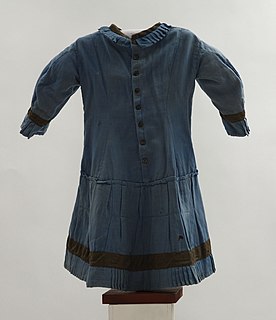
Worsted is a high-quality type of wool yarn, the fabric made from this yarn, and a yarn weight category. The name derives from Worstead, a village in the English county of Norfolk. That village, together with North Walsham and Aylsham, formed a manufacturing centre for yarn and cloth in the 12th century, when pasture enclosure and liming rendered the East Anglian soil too rich for the older agrarian sheep breeds. In the same period, many weavers from the County of Flanders moved to Norfolk. "Worsted" yarns/fabrics are distinct from woollens : the former is considered stronger, finer, smoother, and harder than the latter.
Woolen or woollen is a type of yarn made from carded wool. Woolen yarn is soft, light, stretchy, and full of air. It is thus a good insulator, and makes a good knitting yarn. Woolen yarn is in contrast to worsted yarn, in which the fibers are combed to lie parallel rather than carded, producing a hard, strong yarn.
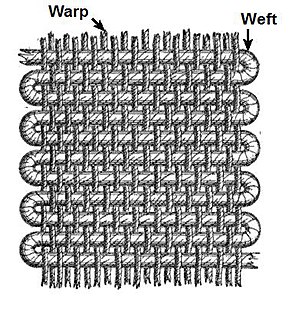
Warp and weft are the two basic components used in weaving to turn thread or yarn into fabric. The lengthwise or longitudinal warp yarns are held stationary in tension on a frame or loom while the transverse weft is drawn through and inserted over and under the warp. A single thread of the weft crossing the warp is called a pick. Terms vary. Each individual warp thread in a fabric is called a warp end or end.
In the textile arts, plying is a process of twisting one or more strings of yarn together to create a stronger yarn. Strands are twisted together in the direction opposite that in which they were spun. Plied yarns will not unravel, break, or degrade as easily as unplied yarns. When enough twist is added to the plies to counter the initial twist of each strand, the resulting yarn is "balanced", having no tendency to twist upon itself.
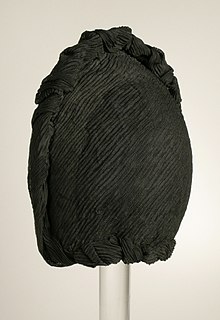
Crêpe, also spelled crepe or crape is a silk, wool, or synthetic fiber fabric with a distinctively crisp and crimped appearance. The term "crape" typically refers to a form of the fabric associated specifically with mourning. Crêpe was also historically called "crespe" or "crisp".

Khadi, derived from khaddar, is a hand-spun and woven natural fibre cloth promoted by Mahatma Gandhi as swadeshi (self-sufficiency) for the freedom struggle of the Indian subcontinent, and the term is used throughout India, Pakistan and Bangladesh. The first piece of the hand-woven cloth was manufactured in the Sabarmati Ashram during 1917–18. The coarseness of the cloth led Gandhi to call it khadi. The cloth is made from cotton, but it may also include silk or wool, which are all spun into yarn on a charkha. It is a versatile fabric that remains cool in summer and warm in winter. To improve its appearance, khadi is sometimes starched to give it a stiffer feel. It is widely accepted in various fashion circles. Popular dresses are made using khadi cloth such as dhoti, kurta, and handloom saris such as Puttapaka Saree, Kotpad Handloom fabrics, Chamba Rumal, and Tussar silk. Gajam Anjaiah, an Indian master handloom designer and a recipient of the Padma Shri, is known for his innovation and development of tie-dye handloom products along with the Telia Rumal technique of weaving products based on the Ikat process.

Sateen is a fabric made using a satin weave structure, but made with spun yarns instead of filament.

The spinning mule is a machine used to spin cotton and other fibres. They were used extensively from the late 18th to the early 20th century in the mills of Lancashire and elsewhere. Mules were worked in pairs by a minder, with the help of two boys: the little piecer and the big or side piecer. The carriage carried up to 1,320 spindles and could be 150 feet (46 m) long, and would move forward and back a distance of 5 feet (1.5 m) four times a minute. It was invented between 1775 and 1779 by Samuel Crompton. The self-acting (automatic) mule was patented by Richard Roberts in 1825. At its peak there were 50,000,000 mule spindles in Lancashire alone. Modern versions are still in niche production and are used to spin woollen yarns from noble fibres such as cashmere, ultra-fine merino and alpaca for the knitware market.

Tufting is a type of textile manufacturing in which a thread is inserted on a primary base. It is an ancient technique for making warm garments, especially mittens. After the knitting is done, short U-shaped loops of extra yarn are introduced through the fabric from the outside so that their ends point inwards.
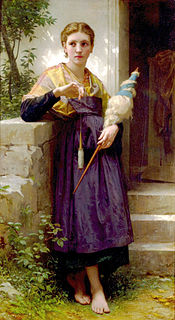
Spinning is an ancient textile art in which plant, animal or synthetic fibres are drawn out and twisted together to form yarn. For thousands of years, fibre was spun by hand using simple tools, the spindle and distaff. It was only with the invention of the spinning wheel in the Islamic world circa 1030, and its subsequent introduction to China, India and Europe in the High Middle Ages, that the output of individual spinners dramatically increased. Mass production later arose in the 18th century with the beginnings of the Industrial Revolution. Hand-spinning remains a popular handicraft.
Chiengora, also called "dog wool," is yarn or wool spun from dog hair. The word is a portmanteau of chien and angora and was coined by an American spinner, Annette Klick. Dog hair is up to 80% warmer than wool and is not elastic.
Ventile, is a registered trademark used to brand a special high-quality woven cotton fabric first developed by scientists at the Shirley Institute in Manchester, England. Originally created to overcome a shortage of flax used for fire hoses and water buckets, its properties were also found to be ideal for pilots' immersion suits.

Long draw is the spinning technique used to create woolen yarns. It is spun from carded rolags. It is generally spun from shorter stapled fibers. Long draw spun yarns are light, lofty, stretchy, soft, and full of air, thus they are good insulators, and make good knitting yarns.
Textile manufacturing is one of the oldest human activities. The oldest known textiles date back to about 5000 B.C. In order to make textiles, the first requirement is a source of fibre from which a yarn can be made, primarily by spinning. The yarn is processed by knitting or weaving to create cloth. The machine used for weaving is the loom. Cloth is finished by what are described as wet process to become fabric. The fabric may be dyed, printed or decorated by embroidering with coloured yarns.
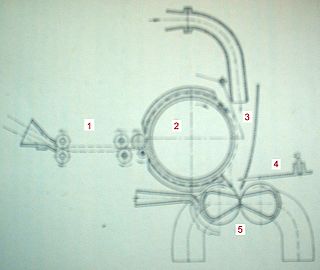
Friction Spinning or Dref Spinning is a textile technology that suitable for spinning coarse counts of yarns and technical core-wrapped yarns. Dref yarns are bulky, with low tensile strength making them suitable for blankets and mop yarns, they can be spun from asbestos, carbon fibres and makes filters was water systems. Yarns such as Rayon and Kevlar can be spun using this method. The technology was developed around 1975 by Dr. Ernst Fehrer.
Doubling is a textile industry term synonymous with combining. It can be used for various processes during spinning. During the carding stage, several sources of roving are doubled together and drawn, to remove variations in thickness. After spinning, yarn is doubled for many reasons. Yarn may be doubled to produce warp for weaving, to make cotton for lace, crochet and knitting. It is used for embroidery threads and sewing threads, for example: sewing thread is usually 6-cable thread. Two threads of spun 60s cotton are twisted together, and three of these double threads are twisted into a cable, of what is now 5s yarn. This is mercerised, gassed and wound onto a bobbin.
Vegetable flannel is a type of flannel using fibres from the Scots pine, or Pinus sylvestris, rather than traditional woollen fibres. It is described as having a hemp like appearance, but with a tighter, softer texture. In addition to this, the term can also describe coarse linen used for underclothing.
A blend is a mixture of two or more fibers. In yarn spinning, different compositions, lengths, diameters, or colors may be combined to create a blend. Blended textiles are fabrics or yarns produced with a combination of two or more types of different fibers, or yarns to obtain desired traits and aesthetics. Blending is possible at various stages of textile manufacturing. The term, blend, refers to spun fibers or a fabric composed of such fibers. There are several synonymous terms: a combination yarn is made up of two strands of different fibers twisted together to form a ply; a mixture or mixed cloth refers to blended cloths in which different types of yarns are used in warp and weft sides.
References
- 1 2 Tortora, Phyllis G.; Merkel, Robert S. (1996-01-10). Fairchild's Dictionary of Textiles (7th ed.). New York: Fairchild Publications. p. 566. ISBN 9780870057076.
- ↑ "Trademark Electronic Search System (TESS)" . Retrieved 2 July 2018.